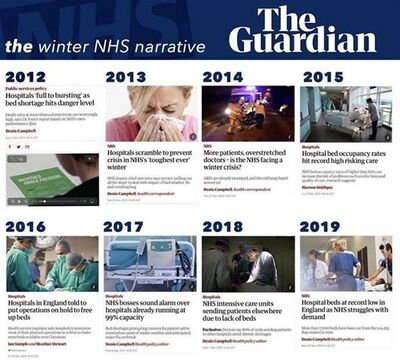"Overwhelmed Intensive Care Units"
 The narrative of overwhelmed ICUs has building up over a long time, as shown by these Guardian headlines. | |
| Date | March 2020 - 2022? |
|---|---|
| Description | From the beginning of the COVID-19 deep event came a drumroll of messages of overwhelmed Intensive Care Units (ICUs). In the large majority of cases, this was a lie. Revealingly, most countries have not increased number of ICU beds |
"Overwhelmed Intensive Care Units" at hospitals has been a mantra from the beginning of the COVID-19 deep event. In the large majority of cases, this was a direct lie. Hospitals, especially in the US, received large financial incentives to put people in ICUs.
For economic reasons, ICUs are normally planned to be run at fairly high capacity (80%), even in normal years.
Protocol changes, with cumbersome hygiene and distancing rules, made all hospital work much slower.
Revealingly, most countries did not increase the number of ICU beds since March 2020 at all, and many have reduced them.[citation needed] By October 2021 he "overwhelmed ICUs" was used as a pretext for denial of access to health services, directed against no recipients of the experimental "COVID vaccines".[citation needed]
Germany
At the beginning of the event in March 2020, there were around 28,000 intensive care beds in Germany. Politicians spoke gravely of the issue and gave almost 700 million euros to the hospitals for 13,700 additional beds[1]. So theoretically it should be 41,700 intensive care beds available by November 2021. In reality there were only 22,230 beds and, according to the intensive care register, only 2,439 of them are free. The beds were paid for by the taxpayer and are physically there - mostly still in their original packaging in the basement.[2]
Australia
In April 2020 the Premier of the state of Victoria, which went hard on the Corona-narrative, announced the creation of 4000 new ICU beds, in addition to the existing 450-500. By August 2021, the actual number had been reduced to 437.[3]
United Kingdom
In March 2020 five emergency ('Nightingale') hospitals, with the capacity to treat almost 10 000 covid-19 cases, were opened across the country for fear the NHS might be overwhelmed. But such high demand for intensive care never materialised. Just 51 patients were treated at the 4000 bed medical facility situated in the refurbished Excel Centre in London’s Docklands since it opened. Nightingale units in Birmingham and Harrogate have not treated a single patient, while a facility in Manchester has had just a handful of admissions.[4]
By November 2020 hospital intensive care was no busier than normal for the majority of hospitals. An NHS source said: “As you can see, our current position in October is exactly where we have been over the last five years.” The data shows that even in the peak in April, critical care beds were never more than 80 per cent full.[5]
The UK Treasury agreed in March 2020 to pay undisclosed billions in a deal to block-book the entire capacity of all 7,956 beds in England’s 187 private hospitals. However, a report from the Centre for Health and the Public Interest says that on 39% of days between March 2020 and March 2021, private hospitals treated no Covid patients at all and on a further 20% of days they cared for only one person. Overall, they provided only 3,000 of the 3.6m Covid bed days in those 13 months – just 0.08% of the total.[6][7]
Norway
In March 2020, Norway had 289 intensive care units. Almost two years later, the capacity had been reduced. At the same time, the government used the alleged danger of overwhelmed ICUs to prepare a new lockdown.[8]
References
- ↑ https://www.aerzteblatt.de/archiv/220623/Intensivbetten-Aufklaerung-ueber-13-700-Betten
- ↑ https://www.nachdenkseiten.de/?p=78143
- ↑ https://www.news.com.au/national/victoria/politics/questions-raised-over-victorian-premiers-promise-of-13-billion-for-4000-icu-beds-in-april-2020/news-story/2e65cabf621fc0be65a84476238256a4
- ↑ https://www.bmj.com/content/369/bmj.m1860
- ↑ https://anti-empire.com/only-four-hospitals-in-the-whole-of-england-are-busier-now-than-last-winter/
- ↑ https://chpi.org.uk/wp-content/uploads/2021/09/CHPI-For-Whose-Benefit_.pdf
- ↑ https://www.theguardian.com/world/2021/oct/07/private-hospitals-treated-eight-covid-patients-a-day-during-pandemic-says-report
- ↑ https://www.an.no/sykehusenes-hovedproblem-er-ikke-pandemien-men-for-lav-intensivkapasitet-over-mange-ar/o/5-4-1511315